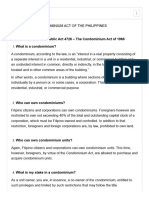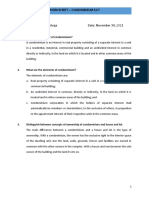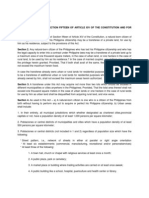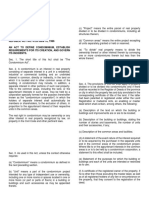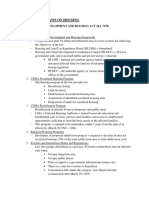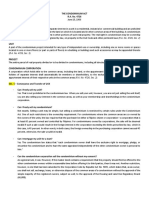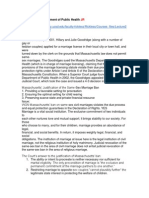Condominium Draft
Condominium Draft
Uploaded by
Keyba Dela CruzCopyright:
Available Formats
Condominium Draft
Condominium Draft
Uploaded by
Keyba Dela CruzCopyright
Available Formats
Share this document
Did you find this document useful?
Is this content inappropriate?
Copyright:
Available Formats
Condominium Draft
Condominium Draft
Uploaded by
Keyba Dela CruzCopyright:
Available Formats
CO-OWNERSHIP
Co-ownership is a form of ownership whereby two or more persons absolutely own the
entire property.
Under the New Civil Code is a provision that substantially provide for a
PERPENDICULAR CO-OWNERSHIP which has a different stories of a house belong to
different owners. Although there are apparently separate and distinct properties, these are
indestructively united for their ornamentation and use and even for their very existence with
other necessary and essential things which are the main and party walls, the roof and other
things used in common. (Art. 490, NCC)
This is to be distinguished from a CONDOMINIUM, which is a building consisting of
several stories, each story being divided into different units owned by different persons who are
members or shareholders of a condominium corporation.
The R.A. 4726 known as Condominium Act is the special law for this type of co-
ownership. This is also a one of the sources of co-ownership. It may treat as a special rule on
co-ownership since it has its unique concept.
Republic Act No. 4726
THE CONDOMINIUM ACT
I. BACKGROUND
The word condominium refers to a type of home ownership whereby an individual
acquires ownership of the interior of a unit, together with an undivided interest in the common
elements of a condominium corporation. A condominium may include, in addition, a separate
interest in other portions of such real property. Title to the common areas, including the land,
or the appurtenant interests in such areas, may be held by a corporation specially formed for
the purpose (known as the condominium corporation) in which the holders of separate
interest shall automatically be members or shareholders, to the exclusion of others, in
proportion to the appurtenant interest of their respective units in the common areas.
II. DEFINITION
A CONDOMINIUM is an interest in real property consisting of separate interest in a
unit in a residential, industrial or commercial building and an undivided interest in common,
directly or indirectly, in the land on which it is located and in other common areas of the
building. (Sec. 2, R.A. 4726)
A. CONCEPT OF CONDOMINIUM
The Concept of Condominium was coined in Roman Times and was recognized
as a CONCEPT of OWNERSHIP of property in France's 1804 Napoleonic Code. It was now used
widely throughout the world , known as "STRATA Tilte" in Australia and Brithish Comumbia and
"SYNDICATES OF CO OWNERSHIP" in Quebec. The equivalent Concept, introduced in England
and Wales in 2004, and still in its Infacy, is "COMMON-HOLD."
CONDOMINIUM V. HOUSE & LOT
Capacity to buy In house and lot, or lot only or townhouse, alien acquisition
is not allowed. In the condominium concept, alien ownership not to exceed 40% interest in
the project is legally allowed
Extent of ownership the interest of the owner in house and lot consists of
absolute ownership of the inner and outer structures of the building (the entire building). In
the condominium concept, the unit owner is the absolute owner of the space within the
interior surface of his unit, but is only a co-owner of the exterior or faade of the unit
CONDOMINIUM V. CO-OWNERSHIP ?
1. Condominium Corporation
Optional and Mandatory Requirement. The condominium corporation is optional if
no unit will be sold in foreigners. However, the corporation is mandatory if some units, not
exceeding forty percent interest in the project, will be sold to foreigners, in which case title to
the land will be transferred in the name of the condominium corporation and thus comply with
the constitutional mandate that corporations may acquire real estate provided that at least sixty
percent of its capital or membership is Filipino. (Sec. 5, R.A. 4726)
BY LAWS. Every condominium has a set of bylaws. Make sure that you understand all
of the bylaws.
Owners may make or amend bylaws by passing a motion to adopt the bylaws or
changes. At least two-thirds of the owners have to agree to the changes. The new bylaws are
effective after the board registers them at the Land Titles Office.
All owners and people occupying a unit are bound by the bylaws and rules of the
corporation. If there is a conflict between the bylaws and the Condominium Act, the Act applies.
The bylaws may give the corporation the right to impose sanctions, like fines, on owners who
fail to comply with the bylaws. The bylaws may also provide that the owners may make rules
governing the use of the common property.
2. Interest in real property
*Title to the common areas may be held by a corporation specially formed for the
purpose, in which holders of separate interests automatically become members or shareholders.
(Sec 2, R.A 4728)
Unit- means a part of the condominium project intended for any type of independent
use or ownership, including accessories appended.
Project- the entire parcel of real property divided, including all structures thereon.
Common areas- means the entire project excepting all units separately granted or held
or reserved.
To divide real property- means to divide the ownership thereof or other interest therein
by conveying one or more condominiums therein but less than the whole thereof. (Sec 3, R.A
4728)
3. Concept of common areas, amendment
Under Regalian Doctrine : Ownership of land in the Philippines is highly-regulated
with land ownership reserved for persons or entities considered Philippine nationals
or Filipino citizens. For this purpose, a corporation owned 60% by Filipino citizens is
treated as a Philippine national. Foreigners interested in acquiring land or real
property through aggressive ownership structures must consider the provisions of the
Philippines' Anti-Dummy Law to determine how to proceed. A major restriction in the
law is the restriction on the number of alien members on the Board of Directors of a
landholding company which is limited to 40% alien participation. Another concern is
the possible forfeiture of the property if the provisions of the law is breached.
Exceptions to the restriction on foreigners acquisition of land in the Philippines are
the following:
1. Acquisition before the 1935 constitution
2. Acquisition through hereditary succession if the foreigner is a legal or natural heir
3. Purchase of not more than 40% interest in a condominium project
4. Purchase by a former natural-born Filipino citizen subject to the limitations
prescribed by law. (natural born Filipinos who acquired foreign citizenship is entitled
to own up to 1,000 sq.m. of residential land, and 1 hectare of agricultural or farm
land)
5. Filipinos who are married to aliens who retain their Filipino citizenship, unless by
their act or omission they have renounced their Filipino citizenship.
When Ownership of the Unit is Acquired?
1. Ownership is acquired only after the buyer had fully paid the purchase price.
2. The ownership of the unit is what makes the buyer a shareholder in the
condominium.
Note: The condominium law effectively separates the building from the land (by
a master deed)
3. Building is deemed an accessory
Amendments
Co-ownership in common areas means shared expenses in these areas
1. Sec 4: simple majority of the property
2. Sec 16: common areas may be disposed by affirmative vote of a simple majority of
the registered owners
Extent of interest in common areas
In the absence of any provision in the master deed, all unit owners shall have equal
share in the common areas. If the intent is to pro-rate the unit owners interest on the common
areas, such fact must be expressly provided in the master deed. The interest based on floor
area of ownership is arrived at by dividing the unit area by the total floor area of all
condominium units.
4. Documents to consider (master deed, declaration of restrictions, articles and
by-laws of the condominium corporation or the association, where applicable)
APPLICABILITY:
Property divided or to be divided into condominiums only if there shall be
recorded in the Register of Deeds of the province or city in which the property
lies and duly annotated in the corresponding certificate of title of the land, if the
latter had been patented or registered under either the Land Registration or
Cadastral Acts, an enabling or master deed
Contents of Master Deed
Technical description of the land.
Description of the building (number of storeys) and condominium units.
Description of the common areas and facilities.
Interests acquired by unit buyers.
Purposes for which the building and units are to be used.
Certification by the landowner, if he is other than the party executing the
master deed, that he is agreeable to the registration of the master deed
on his title.
Certification by the landowner, if he is other than the party executing the
master deed, that he is agreeable to the registration of the master deed
on his title.
Annexes: land survey plan and building diagrammatic floor plan
Contents of deed of restriction
Management body
Provisions for insurance coverage
Maintenance of the common areas
Realty tax on the common areas
Use restrictions
Manner of amending
Independent audit
Dues and assessments
5. TRANSFER OR CONVEYANCE
Any transfer or conveyance of a unit or an apartment, office or store or other space
therein, shall include the transfer or conveyance of the undivided interests in the common areas
or, in a proper case, the membership or shareholdings in the condominium corporation:
Provided, however, That where the common areas in the condominium project are owned by
the owners of separate units as co-owners thereof, no condominium unit therein shall be
conveyed or transferred to persons other than Filipino citizens, or corporations at least sixty
percent of the capital stock of which belong to Filipino citizens, except in cases of hereditary
succession. (SEC. 5, R.A. 4726)
Incidents of a condominium grant
(a) The boundary of the unit granted are the interior surfaces of the perimeter walls,
floors, ceilings, windows and doors thereof.
The following are not part of the unit bearing walls, columns, floors, roofs, foundations and
other common structural elements of the building: lobbies, stairways, hallways, and other
areas of common use, elevator equipment and shafts, central heating, central refrigeration
and central air-conditioning equipment, reservoirs, tanks, pumps and other central services
and facilities, pipes, ducts, flues, chutes, conduits, wires and other utility installations,
wherever located, except the outlets thereof when located within the unit.
(b) There shall pass with the unit, as an appurtenance thereof, an exclusive
easement for the use of the air space encompassed by the boundaries of the unit as it
exists at any particular time and as the unit may lawfully be altered or reconstructed from
time to time. Such easement shall be automatically terminated in any air space upon
destruction of the unit as to render it untenantable.
(c) Unless otherwise, provided, the common areas are held in common by the
holders of units, in equal shares, one for each unit.
(d) A non-exclusive easement for ingress, egress and support through the common
areas is appurtenant to each unit and the common areas are subject to such easements.
(e) Each condominium owner shall have the exclusive right to paint, repaint, tile,
wax, paper or otherwise refinish and decorate the inner surfaces of the walls, ceilings,
floors, windows and doors bounding his own unit.
(f) Each condominium owner shall have the exclusive right to mortgage, pledge or
encumber his condominium and to have the same appraised independently of the other
condominiums but any obligation incurred by such condominium owner is personal to him.
(g) Each condominium owner has also the absolute right to sell or dispose of his
condominium unless the master deed contains a requirement that the property be first
offered to the condominium owners within a reasonable period of time before the same is
offered to outside parties;
GENERAL Rule: Common areas shall remain undivided and there shall be no judicial
partition thereof:
EXCEPTIONS:
(a) That three years after damage or destruction to the project which renders
material part thereof unit for its use prior thereto, the project has not been rebuilt or
repaired substantially to its state prior to its damage or destruction, or
(b) That damage or destruction to the project has rendered one-half or more of the
units therein untenantable and that condominium owners holding in aggregate more
than thirty percent
interest in the common areas are opposed to repair or restoration of the project; or
(c) That the project has been in existence in excess of fifty years, that it is obsolete
and uneconomic, and that condominium owners holding in aggregate more than fifty
percent interest in the common areas are opposed to repair or restoration or remodeling
or modernizing of the project; or
(d) That the project or a material part thereof has been condemned or expropriated
and that the project is no longer viable, or that the condominium owners holding in
aggregate more than seventy percent interest in the common areas are opposed to
continuation of the condominium regime after expropriation or condemnation of a
material portion thereof; or
(e) That the conditions for such partition by sale set forth in the declaration of
restrictions, duly registered have been met.
DECLARATION OF RESTRICTIONS
(a) As to any such management body;
(b) The manner and procedure for amending such restrictions: Provided, That the vote of
not less than a majority in interest of the owners is obtained.
(c) For independent audit of the accounts of the management body;
(d) For reasonable assessments to meet authorized expenditures, each condominium unit to
be assessed separately for its share of such expenses in proportion (unless otherwise
provided) to its owners fractional interest in any common areas;
(e) For the subordination of the liens securing such assessments to other liens either
generally or specifically described;
(f) Such right to partition or dissolution may be conditioned upon failure of the
condominium owners to rebuild within a certain period or upon specified inadequacy of
insurance proceeds, or upon specified percentage of damage to the building, or upon a
decision of an arbitrator, or upon any other reasonable condition.
B. PARTIES
1. The condominium corporation is made up of the owners of all the units in the
condominium.
2. The unit owners elected a board of directors to carry out the corporations
responsibilities.
3. An agent or employee of the corporation can act on behalf of the corporation.
4. Owner of the Land
C) RIGHTS AND OBLIGATIONS OF CONDOMINIUM OWNERS
1. Contributions/ Dues
Rights of unit owner:
Absolute ownership of his unit
Co-ownership of land and common areas
Exclusive easement of the space of his unit
Non-exclusive easement to common areas for ingress or egress
Right to sell, lease, or mortgage his unit
Right to repair, paint, decorate the interior surface of his unit
Right to participate and vote in condominium corporation meetings
Obligations of condominium unit owner
Pay the realty tax on his unit.
Share the realty tax on the land and common areas.
Pay the insurance on his unit.
Share the insurance on the common areas.
Comply with use restrictions.
Pay dues and assessments.
Give other unit owners the priority right to buy his unit (right of first refusal). If
so required by the master deed.
Dues and Assessments
The Deed of Restriction usually provides for two kinds of assessments:
Regular assessment a monthly obligation to fund ordinary project expenses,
such as security, garbage collection, repair and maintenance of the common areas,
electricity and water bills on the common areas and realty tax and insurance on the
common areas.
Special assessment this is imposed as the need arises, such as the need for
replacement of the generator.
Currently, there are only two laws that provide refund for those who default on
their installment payments: the Maceda Law and PD 957.
2. P.D. 957, The Subdivision and Condominium Buyers' Protective Decree
Presidential Decree No. 957 otherwise known as Subdivision and Condominium
Buyers Protective Decree was initiated by the late President Ferdinand Marcos on July
12,1976 and applied with the latest revised implementing rules and regulations in 2009.
PD 957 is for those seeking refund due to the fault of the developer.
How does PD 957 safeguard the welfare of home buyers?
Every project, whether its a subdivision or a condominium, goes through a
stringent series of applying for and seeking approval of several permits, clearances and
certificates from a number of government agencies, primarily from HLURB. Among
others, these are the Development Permit, Certificate of Registration and License to Sell.
In the developers application for a Certificate of Registration, the following are
attached as annexes:
1. Sworn registration statement is basically a promise by the developer to comply with
all the rules and regulations pertaining to the project and to be responsible for all the
facilities, improvements, infrastructures and similar developments thereon
2. Certified true copy of titles
3. Duly audited balance sheet
4. Articles of Incorporation, By-laws and latest annual corporate report to SEC
5. Copy of brochure, circular or prospectus for advertisement
6. Sample copy of Contract to Sell
7. Affidavit signifying willingness to change name (in case there is a project already
registered whose name is similar to that of the developers)
8. Environmental Compliance Certificate (from the DENR)
9. Approved verified survey plan
10. In case of a condominium, a Master Deed with declaration of restrictions duly
annotated at the back of the title/s and plans registered with the Register of Deeds
11. Sanggunian Resolution or Ordinance approving the subdivision plan or Development
Permit
12. Approved subdivision plan by the LGU. In case of a condominium, approved
development permit from the HLURB
13. Engineering plans
14. Topographic plan
15. Project study
16. Recent tax declaration
17. Permit to operate deepwell and a water resistively test
18. Bill of materials and cost of estimates
19. Barangay clearance
The most important part of the License to Sell is the Program of
Development which indicates the projects time of completion. Whereas, for the
Registration, the development plan is the most important. (PHILIPPINE REAL
ESTATE AND CONSTRUCTION)
OTHER GROUNDS:
Section 9 of the PD 957 talks about the revocation of registration certificate and
license to sell.
This is upon a verified valid complaint and satisfactory evidences by the buyer
against the property developers or operators of the following grounds:
a) Is insolvent; or
b) has violated any of the provisions of this Decree or any applicable rule
or regulation of the Authority, or any undertaking of his/its performance bond; or
c) Has been or is engaged or is about to engage in fraudulent transactions; or
d) Has made any misrepresentation in any prospectus, brochure, circular or other
literature about the subdivision project or condominium project that has been distributed
to prospective buyers; or
e) Is of bad business repute; or
f) Does not conduct his business in accordance with law or soundnbusiness principles
Aside from the above mentioned sanction to the owner or the developer of the
condominium or subdivision project, Section23 of P.D. 957 (Section 24 in the
2009 revised IRR for PD 957) covers the most common dilemma of property buyers,
delay in the delivery of the project. (Philippine Property Expert)
SECTION 23. Non-Forfeiture of Payments.
No installment payment made by a buyer in a new or existing subdivision or
condominium project for the lot or unit he contracted to buy shall be forfeited in favor of
the owner or developer when the buyer, after due notice to the owner or developer desists
from further payment due to the failure of the owner or developer to develop the project
according to the approved plans and within the time limit for complying with the same.
Such buyer may at his option be reimbursed the total amount paid including amortization
interests but excluding delinquency interests, with interest thereon at the legal rate.
It is almost always that buyers of the condominium or subdivision properties
cannot do anything about the announcement of delays in the delivery of their purchase.
However with Section 23 of P.D. 957, the buyer has 2 options
1. Desist from further payment after due notice to the owner or developer of the project
and clearance from the Board (HLURB) as mandated in the 2009 revised implementing
rules and regulations for the decree. See the 2009 revised IRR for PD 957 here.
2. Be reimbursed the total amount paid including amortization interests but excluding
delinquency interests, with interest thereon at the legal rate.
Here is another misleading activity, the NO DOWN PAYMENT ad in the flyers of
sales agents and brokers.
SECTION 19. Advertisements. Advertisements that may be made by the owner or
developer through newspaper, radio, television, leaflets, circulars or any other form about
the subdivision or the condominium or its operations or activities must reflect the real
facts and must be presented in such manner that will not tend to mislead or deceive
the public.
The owner or developer shall [be] answerable and liable for the
facilities, improvements, infrastructures or other forms of development represented
or promised in brochures, advertisements and other sales propaganda disseminated by the
owner or developer or his agents and the same shall form part of the sales warranties
enforceable against said owner or developer, jointly and severally. Failure to comply
with these warranties shall also be punishable in accordance with the penalties provided
for in this Decree.
The NO DOWN PAYMENT promotion when presented to common people,
will most likely be perceived as no equity required for the unit and the buyer will just
have to mortgage the whole amount or otherwise pay the total contract price upfront.
In actuality, this NO DOWN PAYMENT means there is no lump sum amount
needed for the down payment to purchase the unit. This is because the down payment or
the equity of the property is stretched out to the allowable term given by the developer or
owner of the project.
Most importantly, know Section 33 of this P.D which states:
SECTION 33. Nullity of Waivers. Any condition, stipulation, or provision in contract
of sale whereby any person waives compliance with any provision of this Decree or of
any rule or regulation issued thereunder shall be void.
Purchasing a real estate property is very exciting especially if it is your first time.
Oftentimes, emotions can carry the buyer away. Sadly, theres a number of
misrepresentations going on right now to overwhelm your emotion in the real estate
industry so as a prudent buyer of a real estate property it is very important to know your
rights and the laws which protect these rights. (PHILIPPINE PROPERTY EXPERT)
3. R.A. 6552, Realty Installment Buyer Act
This is the law that lays out a defaulting buyers rights in the Philippines with
regards to his purchase of a real estate property, whether its a condominium unit or a
house-and-lot unit in a subdivision development. This was initiated by lawmaker
Ernesto Maceda and has taken into effect on August 26, 1972. This is the what they
call MACEDA LAW
Maceda Law is for those defaulting buyers seeking refund resulting from
their inability to pay.
Under the Maceda Law, there are two qualification categories of buyers accorded
protection.
These buyers are:
1. Under Section 3 of Maceda Law, a buyer with at least 2 years of installments
2. Under Section 4 of Maceda Law, a buyer with less than 2 years of installments
Section 3
where the buyer has paid at least two years of installments, the buyer is entitled to the
following rights in case he defaults in the payment of succeeding installments:
a.) To pay, without additional interest, the unpaid installment due within the total grace
period earned by him, which is hereby fixed at the rate of one month grace period for
every one year of installment payments made; provided that this right shall be exercised
by the buyer only once in every five years of the life of the contract and its extensions, if
any.
b.) If the contract is cancelled, the seller shall refund to the buyer the cash surrender value
of the payments on the property equivalent to fifty percent of the total payments made
Down payments, deposits or options on the contract shall be included in the computation
of the total number of installment payments made
Section 4
In case where less than two years of installments were paid, the seller shall give the
buyer a grace period of not less than sixty days from the date the installment became due.
If the buyer fails to pay the installments due at the expiration of the grace period, the
seller may cancel the contract after 30 days from the receipt by the buyer the notice of
cancellation of the demand for rescission of the contract by a notarial act.
In other words, Section 3 of Maceda Law indicates that the buyer has a right to a
refund and grace periods as long as the buyer has paid at least two years. However, if
theres still less than 2 years of installment payments made, the buyer is only entitled to
60 days grace period as indicated in Section 4.
More importantly, there is a section in the Maceda Law that protects the buyers
from the fine prints of contracts imposed by the contractors or developers. These fines
prints are oftentimes neglected by the buyers to review during the contract signing.
Section 7 of the Maceda Law states that Any stipulation in any contract hereafter
entered into contrary to the provisions of Sections 3,4,5, and 6 shall be null and void.
(PHILIPPINE PROPERTY EXPERT)
D.) GROUNDS FOR PARTITION OF COMMON AREAS, OR DISSOLUTION OF THE
CONDOMINIUM
Term of a condominium corporation. Co-terminus with the duration of the
condominium project, the provisions of the Corporation Law to the contrary notwithstanding.
(Sec. 11, R.A. NO. 4726)
Involuntary dissolution of a condominium corporation. Effect. The
common areas owned or held by the corporation shall, by way of liquidation, be transferred
pro-indiviso and in proportion to their interest in the corporation to the members or
stockholders thereof, subject to the superior rights of the corporation creditors. Such transfer or
conveyance shall be deemed to be a full liquidation of the interest of such members or
stockholders in the corporation. After such transfer or conveyance, the provisions of this Act
governing undivided coownership of, or undivided interest in, the common areas in
condominium projects shall fully apply. (Sec. 12, R.A. NO. 4726)
Corporation not Voluntary Dissolved if Master deed not revoked, except if
conditions on partition is present(Sec. 8, R.A. NO. 4726)
Affirmative vote of all the stockholders or members thereof at a general
or special meeting duly called for the purpose, dissolves the corporation provided
requirements of Corporation Law complied.
Affirmative vote of all the stockholders or members necessary to dispose,
lease, exchange of common areas owned or held by it in the condominium project
Effects of Voluntary Dissolution. Unless otherwise provided in the Deed of
Restriction, the corporation shall be deemed to hold a power of attorney from all the
members to sell their separate interest in the project. Liquidation of the corporation shall
be effected by the sale of the entire project, subject to the rights of individual creditors
(Sec. 13, R.A. NO. 4726)
You might also like
- Condominium Concepts and Other Specilized Development Prelims MIdterm ModuleDocument20 pagesCondominium Concepts and Other Specilized Development Prelims MIdterm ModuleAndie Mie Romanos67% (3)
- Condominium-Act PresentationDocument36 pagesCondominium-Act PresentationJei Nicole100% (1)
- Condominium ConceptsDocument7 pagesCondominium ConceptsMarisseAnne Coquilla100% (3)
- Real Estate SyllabusDocument6 pagesReal Estate SyllabusalyssanuquiNo ratings yet
- Cjs On ArrestDocument433 pagesCjs On Arrestgoldilucks50% (2)
- Republic Act 4726Document5 pagesRepublic Act 4726Jewel CantileroNo ratings yet
- Brokerage PracticeDocument26 pagesBrokerage PracticeElwin F. BuenaventuraNo ratings yet
- MCQDocument37 pagesMCQRochelle Adajar-BacallaNo ratings yet
- RA 4726 and PD 957Document3 pagesRA 4726 and PD 957remingiiiNo ratings yet
- R.A. 4726 - The Condominium Act of The PhilippinesDocument5 pagesR.A. 4726 - The Condominium Act of The PhilippinesFáber XuNo ratings yet
- Worksheet - Condominium ActDocument12 pagesWorksheet - Condominium ActAG OrtegaNo ratings yet
- Ra 4726Document11 pagesRa 4726Dessa ReyesNo ratings yet
- Legal Aspects of SaleDocument7 pagesLegal Aspects of SaleShine Revilla - MontefalconNo ratings yet
- Batas Pambansa 185Document56 pagesBatas Pambansa 185heartiee1018No ratings yet
- Part II. Chapter 2 Imposition of Real Property TaxDocument30 pagesPart II. Chapter 2 Imposition of Real Property TaxRuiz, CherryjaneNo ratings yet
- CONDOMINIUM CONCEPTS. - Note # 1Document4 pagesCONDOMINIUM CONCEPTS. - Note # 1Jay JQ100% (1)
- CONDOMINIUM CONCEPTS. - Note # 1Document4 pagesCONDOMINIUM CONCEPTS. - Note # 1Jay JQNo ratings yet
- Ra 4276Document8 pagesRa 4276Monique Allen LoriaNo ratings yet
- Salient Features of CARLDocument4 pagesSalient Features of CARLColeen Navarro-RasmussenNo ratings yet
- The Philippine Laws On Housing: A. The Urban Development and Housing Act (Ra 7279)Document7 pagesThe Philippine Laws On Housing: A. The Urban Development and Housing Act (Ra 7279)Christen CaliboNo ratings yet
- R-890 S. 2012Document8 pagesR-890 S. 2012mabzicleNo ratings yet
- Notes On PD 957Document2 pagesNotes On PD 957Gelo ArevaloNo ratings yet
- REM123 Assignment 2 - LEGAL REQUIREMENTS FOR REAL ESTATE SERVICE - MCQDocument3 pagesREM123 Assignment 2 - LEGAL REQUIREMENTS FOR REAL ESTATE SERVICE - MCQclaressaemarquezNo ratings yet
- FinalDocument7 pagesFinalHerwin CapinanesNo ratings yet
- PD 957 ReviewerDocument4 pagesPD 957 ReviewerntpamintuannNo ratings yet
- LRA Land Acquisition and OwnershipDocument6 pagesLRA Land Acquisition and OwnershipRandolph AlvarezNo ratings yet
- RA 386 Civil CodeDocument142 pagesRA 386 Civil CodeRoms AvilaNo ratings yet
- Rights Included in Land Ownership (The Bundle of Rights)Document1 pageRights Included in Land Ownership (The Bundle of Rights)Mart MantillaNo ratings yet
- REVISED URBAN Fundamentals Land Ownership by REX DoneDocument56 pagesREVISED URBAN Fundamentals Land Ownership by REX DoneShaneen AngeliqueNo ratings yet
- A Look at The Phillipine EcomomyDocument38 pagesA Look at The Phillipine EcomomyJayvee FelipeNo ratings yet
- Definition of EncumbranceDocument3 pagesDefinition of EncumbranceamvronaNo ratings yet
- Ordinance No. 0309-07Document2 pagesOrdinance No. 0309-07cmv mendozaNo ratings yet
- Presidential Decree No.957: The Subdivision and Condominium Buyers' Protective DecreeDocument15 pagesPresidential Decree No.957: The Subdivision and Condominium Buyers' Protective DecreeCarmina Castillo0% (1)
- Real Estate Development GuideDocument76 pagesReal Estate Development Guideal bentulanNo ratings yet
- Right of AccessionDocument8 pagesRight of AccessionMarie Bernadette BartolomeNo ratings yet
- Topic 3. Maceda LawDocument19 pagesTopic 3. Maceda LawHNo ratings yet
- Be It Enacted by The Senate and House of Representatives of The Philippines in Congress AssembledDocument13 pagesBe It Enacted by The Senate and House of Representatives of The Philippines in Congress AssembledHib Atty TalaNo ratings yet
- BP 220 Group 2 FinalDocument73 pagesBP 220 Group 2 Finalsheyndaga12No ratings yet
- Code of Ethic and Responsibilities - Philippine Real Estate Broker ReviewerDocument16 pagesCode of Ethic and Responsibilities - Philippine Real Estate Broker ReviewerRhea SunshineNo ratings yet
- Arts 562-581 UsucfructDocument17 pagesArts 562-581 UsucfructDuko Alcala EnjambreNo ratings yet
- Ra 6557Document14 pagesRa 6557April Ann Sapinoso Bigay-PanghulanNo ratings yet
- Official Gazette of The Republic of The PhilippinesDocument19 pagesOfficial Gazette of The Republic of The PhilippinesTajimi Castaño100% (1)
- Condominium CodeDocument6 pagesCondominium CodePrincess Sarah PanganibanNo ratings yet
- Appraisal and Assessment in Government SectorDocument2 pagesAppraisal and Assessment in Government SectorluxasuhiNo ratings yet
- Real Estate Service Act (Resa Law) Republic Act 9646Document18 pagesReal Estate Service Act (Resa Law) Republic Act 9646Mike Angelow EsperaNo ratings yet
- Modes of Acquiring Land TitlesDocument3 pagesModes of Acquiring Land TitlesJune Alapa100% (1)
- Condominium Concept and Other Types and Other Types of Real Estate HoldingsDocument15 pagesCondominium Concept and Other Types and Other Types of Real Estate HoldingsRhea Sunshine100% (1)
- 0.06 Mpa Minimum Width of Pathwalks For Condominium Project 1.5% Minimum Slope of Crown of The Road Right-Of-Way 2 M Minimum Width of AlleyDocument15 pages0.06 Mpa Minimum Width of Pathwalks For Condominium Project 1.5% Minimum Slope of Crown of The Road Right-Of-Way 2 M Minimum Width of AlleyJeric Ivan Yee NgoNo ratings yet
- RA 4726 (Condo Act)Document6 pagesRA 4726 (Condo Act)Bianca Margaret TolentinoNo ratings yet
- Architecture NotesDocument23 pagesArchitecture NotesNeil AbellaNo ratings yet
- UntitledDocument21 pagesUntitledBRENDA BRADECINANo ratings yet
- Rental LawDocument4 pagesRental LawQayes Al-QuqaNo ratings yet
- A.1 Fundamentalsrec CodeDocument18 pagesA.1 Fundamentalsrec Codebhobot riveraNo ratings yet
- Introduction To Land Acquisition Plan and Resettlement Action Plan (Laprap Preparation)Document80 pagesIntroduction To Land Acquisition Plan and Resettlement Action Plan (Laprap Preparation)JORGE BEJANo ratings yet
- Act 926 PDFDocument11 pagesAct 926 PDFgivemeasign24No ratings yet
- Real Estate Finance and Economics - Quiz - 22jan2023Document4 pagesReal Estate Finance and Economics - Quiz - 22jan2023harriet dale100% (2)
- In Assignment: Submitted byDocument8 pagesIn Assignment: Submitted byrochel100% (1)
- Condominium Final ExamDocument8 pagesCondominium Final ExamAbu RagnarNo ratings yet
- Condominium Act of The Philippines ExplainedDocument1 pageCondominium Act of The Philippines ExplainedtimothymaderazoNo ratings yet
- Recto Law and Maceda Law (Draft)Document15 pagesRecto Law and Maceda Law (Draft)Lordson RamosNo ratings yet
- R.A. 4726Document4 pagesR.A. 4726dwight yu100% (1)
- Araullo vs. AquinoDocument3 pagesAraullo vs. AquinoKeyba Dela CruzNo ratings yet
- Comelec vs. Padilla FullDocument14 pagesComelec vs. Padilla FullKeyba Dela CruzNo ratings yet
- Torts II3 To 5cDocument56 pagesTorts II3 To 5cKeyba Dela CruzNo ratings yet
- Legal Forms f.167-172Document14 pagesLegal Forms f.167-172Keyba Dela CruzNo ratings yet
- Pancake HouseDocument2 pagesPancake HouseKeyba Dela CruzNo ratings yet
- Berlo'S SMCR Model of CommunicationDocument1 pageBerlo'S SMCR Model of CommunicationKeyba Dela CruzNo ratings yet
- LEG CDocument8 pagesLEG CKeyba Dela CruzNo ratings yet
- Republic of The PhilippinesDocument1 pageRepublic of The PhilippinesKeyba Dela CruzNo ratings yet
- Commission On Elections: Salsa Eza GuzmanDocument3 pagesCommission On Elections: Salsa Eza GuzmanKeyba Dela CruzNo ratings yet
- I. Greek Gods and GoddessesDocument3 pagesI. Greek Gods and GoddessesKeyba Dela CruzNo ratings yet
- NLRC Request LetterDocument2 pagesNLRC Request LetterKeyba Dela CruzNo ratings yet
- Labor Relations - Collective Bargaining Procedure & Agreement - ULP - Concerted Activities (Pages 32-36)Document36 pagesLabor Relations - Collective Bargaining Procedure & Agreement - ULP - Concerted Activities (Pages 32-36)Keyba Dela CruzNo ratings yet
- Labor Relations - Kinds Employee - Prescription of Actions (Pages 37-44)Document43 pagesLabor Relations - Kinds Employee - Prescription of Actions (Pages 37-44)Keyba Dela CruzNo ratings yet
- Facts:: G.R. No. L-45772 March 25, 1988 People vs. Hon. Eduardo Montenegro Padilla, J.Document6 pagesFacts:: G.R. No. L-45772 March 25, 1988 People vs. Hon. Eduardo Montenegro Padilla, J.Keyba Dela CruzNo ratings yet
- PetitionDocument2 pagesPetitionKeyba Dela CruzNo ratings yet
- Negotiable Instruments - Case DigestDocument8 pagesNegotiable Instruments - Case DigestKeyba Dela CruzNo ratings yet
- Horton Homes, Inc. v. United States, 357 F.3d 1209, 11th Cir. (2004)Document6 pagesHorton Homes, Inc. v. United States, 357 F.3d 1209, 11th Cir. (2004)Scribd Government DocsNo ratings yet
- Contemporary Challenges of Cambodian DemocracyDocument35 pagesContemporary Challenges of Cambodian Democracyjpoy61494100% (1)
- MSJ Memo of Law-Sexual Harassment RetaliationDocument15 pagesMSJ Memo of Law-Sexual Harassment RetaliationRich BradfordNo ratings yet
- Rennie Declarador vs. Hon. Salvador S. GubatonDocument4 pagesRennie Declarador vs. Hon. Salvador S. GubatonAJ ArugayNo ratings yet
- Pedro Cosme-Rosado Lydia Esther Rosado-Figueroa Conjugal Partnership Cosme-Rosado Maria Teresa-Cosme Pedro Orlando Cosme-Rodriguez Yaritza Cosme-Rodriguez v. Alfredo Serrano-Rodriguez, as Mayor of the City of Naranjito 3-C Construction Cristino Cruz Jane Doe, 98cv1491 Conjugal Partnership, Cruz-Cruz, 360 F.3d 42, 1st Cir. (2004)Document8 pagesPedro Cosme-Rosado Lydia Esther Rosado-Figueroa Conjugal Partnership Cosme-Rosado Maria Teresa-Cosme Pedro Orlando Cosme-Rodriguez Yaritza Cosme-Rodriguez v. Alfredo Serrano-Rodriguez, as Mayor of the City of Naranjito 3-C Construction Cristino Cruz Jane Doe, 98cv1491 Conjugal Partnership, Cruz-Cruz, 360 F.3d 42, 1st Cir. (2004)Scribd Government DocsNo ratings yet
- 3-2007-Goodridge - PDF: Goodridge v. Department of Public HealthDocument7 pages3-2007-Goodridge - PDF: Goodridge v. Department of Public HealthIñigo Mathay RojasNo ratings yet
- Exhibits 1 To 5 (Skidmore v. Led Zeppelin "Stairway To Heaven" Lawsuit)Document75 pagesExhibits 1 To 5 (Skidmore v. Led Zeppelin "Stairway To Heaven" Lawsuit)James CookNo ratings yet
- Ricalde vs. People of The PhilippinesDocument21 pagesRicalde vs. People of The PhilippinesAnonymous KaNu0py71No ratings yet
- Lahm III & Concepcion V Labor Arbiter MayorDocument5 pagesLahm III & Concepcion V Labor Arbiter MayorRuab Plos0% (2)
- 11-08-30 Yaakov Kadosh V State of Israel (2016/11), Criminal Appeal in The Supreme Court of The State of Israel - Online Public Access Records S (Eng + Heb)Document11 pages11-08-30 Yaakov Kadosh V State of Israel (2016/11), Criminal Appeal in The Supreme Court of The State of Israel - Online Public Access Records S (Eng + Heb)SELA - Human Rights Alert - IsraelNo ratings yet
- Lecture 9 - The Plaint in GeneralDocument64 pagesLecture 9 - The Plaint in GeneralWanjiku MumbiNo ratings yet
- Statutory Construction ReviewerDocument6 pagesStatutory Construction ReviewerMark John Paul Campos100% (3)
- Arundhati Roy Case-1Document7 pagesArundhati Roy Case-1Radhika BiyaniNo ratings yet
- How To File A ComplaintDocument2 pagesHow To File A ComplaintbelteshazzarNo ratings yet
- From Nation-State To Global State, or The Decline of DemocracyDocument20 pagesFrom Nation-State To Global State, or The Decline of DemocracyLara FreireNo ratings yet
- Pacete vs. Comm. On Appointments (G.R. No. L-25895 - July 23, 1971)Document2 pagesPacete vs. Comm. On Appointments (G.R. No. L-25895 - July 23, 1971)Lecdiee Nhojiezz Tacissea SalnackyiNo ratings yet
- SOCIOLOGICAL SCHOOL OF JURISPRUDENCE SEM IV XXDocument8 pagesSOCIOLOGICAL SCHOOL OF JURISPRUDENCE SEM IV XXMasoom RazaNo ratings yet
- Gumabon Vs Director of PrisonsDocument3 pagesGumabon Vs Director of PrisonsKarl Rigo AndrinoNo ratings yet
- CV 8299 AF Moved To Feb 17 2020Document1 pageCV 8299 AF Moved To Feb 17 2020lanariccijpineda021489No ratings yet
- Conflict Five CasesDocument10 pagesConflict Five Casesandrew estimoNo ratings yet
- Risos - Vidal V ComelecDocument2 pagesRisos - Vidal V Comelec上原クリスNo ratings yet
- Consti1 CompiledNotes Executive Judiciary DepartmentsDocument13 pagesConsti1 CompiledNotes Executive Judiciary DepartmentsCedric KhoNo ratings yet
- 263 - Suntay v. KeyserDocument4 pages263 - Suntay v. KeyserUP Law Block DNo ratings yet
- Laird v. Tatum, 408 U.S. 1 (1972)Document29 pagesLaird v. Tatum, 408 U.S. 1 (1972)Scribd Government DocsNo ratings yet
- 101 Things You Want To Know About Police But Were Afraid To AskDocument40 pages101 Things You Want To Know About Police But Were Afraid To AskLatest Laws Team100% (1)
- Pubcorp Cases-ULEPDocument40 pagesPubcorp Cases-ULEPJohn Paulo Say PetillaNo ratings yet
- ABAKADA Guro v. PurisimaDocument95 pagesABAKADA Guro v. PurisimaKRIZEANAE PLURADNo ratings yet
- Andamo v. IACDocument9 pagesAndamo v. IACHershey Delos SantosNo ratings yet
- Delhi Gangrape Case: All Four Convicts Sentenced To DeathDocument4 pagesDelhi Gangrape Case: All Four Convicts Sentenced To DeathAditya PandeyNo ratings yet









